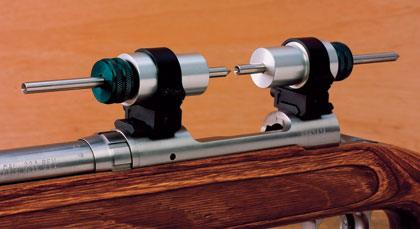After reading this article , I presume that this epoxy bedding would prevent my scope from moving slightly forward from recoil of a .340 Weatherby Magnum .
My rifle would shoot the first 2 shots into same hole at 200 yards and then the group would begin opening up more on each following shot . I was baffled , checking base first , then rings for proper torque , mounting another scope , re-zeroing , and then getting the exact same results . I checked stock bedding , barrel free-float clearance , and weighing all reloading components exactly . Still the same results .
Then I got the idea of checking for scope slippage in the rings . Using a pencil , I marked the scope tube at front and rear of each ring to check for movement . After firing 6 - 8 shots , and watching the shot grouping open , I looked at my marks on the scope tube and found that the scope had moved .050" or slightly more forward from it's original location .
Weatherby Mark V action , Near Mfg. one piece 25 MOA rail , Leupold Mark IV rings , and Leupold Mark IV 4.5 - 14 x 40 LRT , 30mm tube scope with weight at 19 oz. , if I am correct in remembering Leupold specs . Douglas Premium XX barrel with Holland muzzle brake . Overall weight of rifle/scope combo is 10 pounds . 250 gr. bullet @ 3020 FPS ( Magnetospeed ).
Would this slight amount of movement change the point of impact noticeably ?
Get a different set of rings. Scope should not move in a properly mounted set of lapped rings no matter how much recoil a gun has.
Bedding the rail or bases to the receiver makes sense to me. I disagree with the idea of epoxy bedding a set of rings. If a ring is properly made and properly fitted epoxy will not improve the scope to ring fit. Make sure you use an alignment tool to ensure the rings are perfectly in line and no bending action is imparted on the scope tube then lapp the rings for a perfect fit to the scope. I have had great results using Leupold and other rings lapped in place but if you want the ultimate in precision made try buying better quality rings like Near.
http://www.nearmfg.com/

Last edited:
